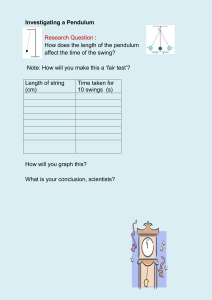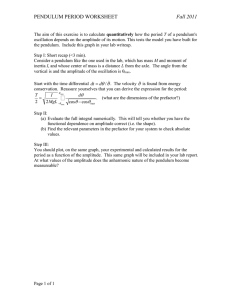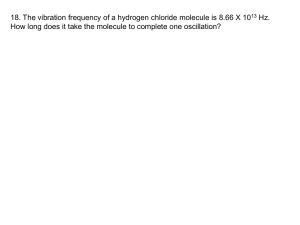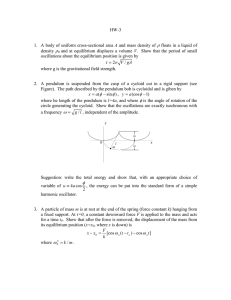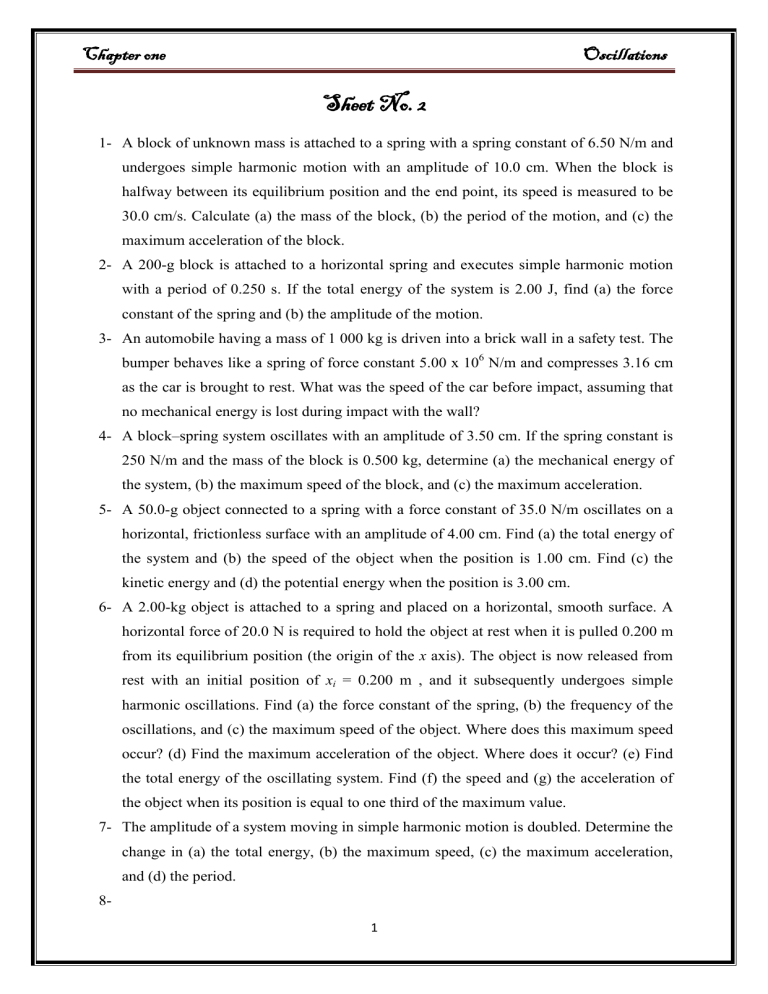
Chapter one Oscillations Sheet No. 2 1- A block of unknown mass is attached to a spring with a spring constant of 6.50 N/m and undergoes simple harmonic motion with an amplitude of 10.0 cm. When the block is halfway between its equilibrium position and the end point, its speed is measured to be 30.0 cm/s. Calculate (a) the mass of the block, (b) the period of the motion, and (c) the maximum acceleration of the block. 2- A 200-g block is attached to a horizontal spring and executes simple harmonic motion with a period of 0.250 s. If the total energy of the system is 2.00 J, find (a) the force constant of the spring and (b) the amplitude of the motion. 3- An automobile having a mass of 1 000 kg is driven into a brick wall in a safety test. The bumper behaves like a spring of force constant 5.00 x 106 N/m and compresses 3.16 cm as the car is brought to rest. What was the speed of the car before impact, assuming that no mechanical energy is lost during impact with the wall? 4- A block–spring system oscillates with an amplitude of 3.50 cm. If the spring constant is 250 N/m and the mass of the block is 0.500 kg, determine (a) the mechanical energy of the system, (b) the maximum speed of the block, and (c) the maximum acceleration. 5- A 50.0-g object connected to a spring with a force constant of 35.0 N/m oscillates on a horizontal, frictionless surface with an amplitude of 4.00 cm. Find (a) the total energy of the system and (b) the speed of the object when the position is 1.00 cm. Find (c) the kinetic energy and (d) the potential energy when the position is 3.00 cm. 6- A 2.00-kg object is attached to a spring and placed on a horizontal, smooth surface. A horizontal force of 20.0 N is required to hold the object at rest when it is pulled 0.200 m from its equilibrium position (the origin of the x axis). The object is now released from rest with an initial position of xi = 0.200 m , and it subsequently undergoes simple harmonic oscillations. Find (a) the force constant of the spring, (b) the frequency of the oscillations, and (c) the maximum speed of the object. Where does this maximum speed occur? (d) Find the maximum acceleration of the object. Where does it occur? (e) Find the total energy of the oscillating system. Find (f) the speed and (g) the acceleration of the object when its position is equal to one third of the maximum value. 7- The amplitude of a system moving in simple harmonic motion is doubled. Determine the change in (a) the total energy, (b) the maximum speed, (c) the maximum acceleration, and (d) the period. 81 Chapter one Oscillations 9- A 65.0-kg bungee jumper steps off a bridge with a light bungee cord tied to herself and to the bridge. The unstretched length of the cord is 11.0 m. She reaches the bottom of her motion 36.0 m below the bridge before bouncing back. Her motion can be separated into an 11.0-m free fall and a 25.0-m section of simple harmonic oscillation. (a) For what time interval is she in free fall? (b) Use the principle of conservation of energy to find the spring constant of the bungee cord. (c) What is the location of the equilibrium point where the spring force balances the gravitational force acting on the jumper? Note that this point is taken as the origin in our mathematical description of simple harmonic oscillation. (d) What is the angular frequency of the oscillation? (e) What time interval is required for the cord to stretch by 25.0 m? (f ) What is the total time interval for the entire 36.0-m drop? 10- A particle executes simple harmonic motion with an amplitude of 3.00 cm. At what position does its speed equal half its maximum speed? 11- A cart attached to a spring with constant 3.24 N/m vibrates with position given by x = (5.00 cm) cos (3.60t rad/s). (a) During the first cycle, for 0 <t < 1.75 s, just when is the system’s potential energy changing most rapidly into kinetic energy? (b) What is the maximum rate of energy transformation? 12- While riding behind a car traveling at 3.00 m/s, you notice that one of the car’s tires has a small hemispherical bump on its rim. (a) Explain why the bump, from your viewpoint behind the car, executes simple harmonic motion. (b) If the radii of the car’s tires are 0.300 m, what is the bump’s period of oscillation? 13- Consider the simplified single-piston engine in Figure. If the wheel rotates with constant angular speed, explain why the piston rod oscillates in simple harmonic motion. 14- A man enters a tall tower, needing to know its height. He notes that a long pendulum extends from the ceiling almost to the floor and that its period is 12.0 s. (a) How tall is the tower? (b) What If? If this pendulum is taken to the Moon, where the free-fall acceleration is 1.67 m/s2, what is its period there? 15- A ―seconds pendulum‖ is one that moves through its equilibrium position once each second. (The period of the pendulum is precisely 2 s.) The length of a seconds pendulum 2 Chapter one Oscillations is 0.992 7 m at Tokyo, Japan and 0.994 2 m at Cambridge, England. What is the ratio of the free-fall accelerations at these two locations? 16- A rigid steel frame above a street intersection supports standard traffic lights, each of which is hinged to hang immediately below the frame. A gust of wind sets a light swinging in a vertical plane. Find the order of magnitude of its period. State the quantities you take as data and their values. 17- The angular position of a pendulum is represented by the equation Ɵ = (0.320 rad) cos ωt, where Ɵ is in radians and ω = 4.43 rad/s. Determine the period and length of the pendulum. 18- A simple pendulum has a mass of 0.250 kg and a length of 1.00 m. It is displaced through an angle of 15.0° and then released. What are (a) the maximum speed, (b) the maximum angular acceleration, and (c) the maximum restoring force? What If? Solve this problem by using the simple harmonic motion model for the motion of the pendulum, and then solve the problem more precisely by using more general principles. 19- A simple pendulum is 5.00 m long. (a) What is the period of small oscillations for this pendulum if it is located in an elevator accelerating upward at 5.00 m/s2? (b) What is its period if the elevator is accelerating downward at 5.00 m/s2? (c) What is the period of this pendulum if it is placed in a truck that is accelerating horizontally at 5.00 m/s2? 20- A particle of mass m slides without friction inside a hemispherical bowl of radius R. Show that, if it starts from rest with a small displacement from equilibrium, the particle moves in simple harmonic motion with an angular frequency equal to that of a simple pendulum of length R. That is √ . 21- A small object is attached to the end of a string to form a simple pendulum. The period of its harmonic motion is measured for small angular displacements and three lengths, each time clocking the motion with a stopwatch for 50 oscillations. For lengths of 1.000 m, 0.750 m, and 0.500 m, total times of 99.8 s, 86.6 s, and 71.1 s are measured for 50 oscillations. (a) Determine the period of motion for each length. (b) Determine the mean value of g obtained from these three independent measurements, and compare it with the accepted value. (c) Plot T 2 versus L, and obtain a value for g from the slope of your best-fit straight-line graph. Compare this value with that obtained in part (b). 22- A physical pendulum in the form of a planar body moves in simple harmonic motion with a frequency of 0.450 Hz. If the pendulum has a mass of 2.20 kg and the pivot is 3 Chapter one Oscillations located 0.350 m from the center of mass, determine the moment of inertia of the pendulum about the pivot point. 23- A very light rigid rod with a length of 0.500 m extends straight out from one end of a meter stick. The stick is suspended from a pivot at the far end of the rod and is set into oscillation. (a) Determine the period of oscillation. Suggestion: Use the parallel-axis theorem from Section 10.5. (b) By what percentage does the period differ from the period of a simple pendulum 1.00 m long? 24- Consider the physical pendulum. (a) If its moment of inertia about an axis passing through its center of mass and parallel to the axis passing through its pivot point is IC.M, show that its period is Where d is the distance between the pivot point and center of mass. (b) Show that the period has a minimum value when d satisfies md2 = IC.M. 25- A torsional pendulum is formed by taking a meter stick of mass 2.00 kg, and attaching to its center a wire. With its upper end clamped, the vertical wire supports the stick as the stick turns in a horizontal plane. If the resulting period is 3.00 minutes, what is the torsion constant for the wire? 26- A clock balance wheel has a period of oscillation of 0.250 s. The wheel is constructed so that its mass of 20.0 g is concentrated around a rim of radius 0.500 cm. What are (a) the wheels moment of inertia and (b) the torsion constant of the attached spring? 27- Show that the time rate of change of mechanical energy for a damped, undriven oscillator is given by dE/dt = - bv2 and hence is always negative. Proceed as follows: Differentiate the expression for the mechanical energy of an oscillator, E= 0.5 mv2 + 0.5 kx2, and use Equation . 28- A pendulum with a length of 1.00 m is released from an initial angle of 15.0°. After 1 000 s, its amplitude has been reduced by friction to 5.50°. What is the value of b/2m? 29- Show that Equation is a solution of Equation provided that b2 < 4mk. 30- A 10.6-kg object oscillates at the end of a vertical spring that has a spring constant of 2.05 x 104 N/m. The effect of air resistance is represented by the damping coefficient b = 3.00 N. s/m. (a) Calculate the frequency of the damped oscillation. (b) By what 4 Chapter one Oscillations percentage does the amplitude of the oscillation decrease in each cycle? (c) Find the time interval that elapses while the energy of the system drops to 5.00% of its initial value. 31- The front of her sleeper wet from teething, a baby rejoices in the day by crowing and bouncing up and down in her crib. Her mass is 12.5 kg, and the crib mattress can be modeled as a light spring with force constant 4.30 kN/m. (a) The baby soon learns to bounce with maximum amplitude and minimum effort by bending her knees at what frequency? (b) She learns to use the mattress as a trampoline— losing contact with it for part of each cycle—when her amplitude exceeds what value? 32- A 2.00-kg object attached to a spring moves without friction and is driven by an external force given by F = (3.00 N) sin (2ωt). If the force constant of the spring is 20.0 N/m, determine (a) the period and (b) the amplitude of the motion. 33- Considering an undamped, forced oscillator (b = 0), show that Equation is a solution of Equation an amplitude given by Equation , with . 34- A weight of 40.0 N is suspended from a spring that has a force constant of 200 N/m. The system is undamped and is subjected to a harmonic driving force of frequency 10.0 Hz, resulting in a forced-motion amplitude of 2.00 cm. Determine the maximum value of the driving force. 35- Damping is negligible for a 0.150-kg object hanging from a light 6.30-N/m spring. A sinusoidal force with an amplitude of 1.70 N drives the system. At what frequency will the force make the object vibrate with an amplitude of 0.440 m? 36- You are a research biologist. You take your emergency pager along to a fine restaurant. You switch the small pager to vibrate instead of beep, and you put it into a side pocket of your suit coat. The arm of your chair presses the light cloth against your body at one spot. Fabric with a length of 8.21 cm hangs freely below that spot, with the pager at the bottom. A coworker urgently needs instructions and calls you from your laboratory. The motion of the pager makes the hanging part of your coat swing back and forth with remarkably large amplitude. The waiter and nearby diners notice immediately and fall silent. Your daughter pipes up and says, ―Daddy, look= Your cockroaches must have gotten out again=‖ Find the frequency at which your pager vibrates. 5 Chapter one Oscillations 37- Four people, each with a mass of 72.4 kg, are in a car with a mass of 1 130 kg. An earthquake strikes. The driver manages to pull off the road and stop, as the vertical oscillations of the ground surface make the car bounce up and down on its suspension springs. When the frequency of the shaking is 1.80 Hz, the car exhibits maximum amplitude of vibration. The earthquake ends, and the four people leave the car as fast as they can. By what distance does the cars undamaged suspension lift the car body as the people get out? 38- A small ball of mass M is attached to the end of a uniform rod of equal mass M and length L that is pivoted at the top. (a) Determine the tensions in the rod at the pivot and at the point P when the system is stationary. (b) Calculate the period of oscillation for small displacements from equilibrium, and determine this period for L = 2.00 m. 39- An object of mass m1 = 9.00 kg is in equilibrium while connected to a light spring of constant k = 100 N/m that is fastened to a wall as shown in Figure a. A second object, m2 = 7.00 kg, is slowly pushed up against m1, compressing the spring by the amount A = 0.200 m, (see Figure b). The system is then released, and both objects start moving to the right on the frictionless surface. (a) When m1 reaches the equilibrium point, m2 loses contact with m1 (see Figure c) and moves to the right with speed v. Determine the value of v. (b) How far apart are the objects when the spring is fully stretched for the first time (D in Figure d)? (Suggestion: First determine the period of oscillation and the amplitude of the m1–spring system after m2 loses contact with m1) 6
